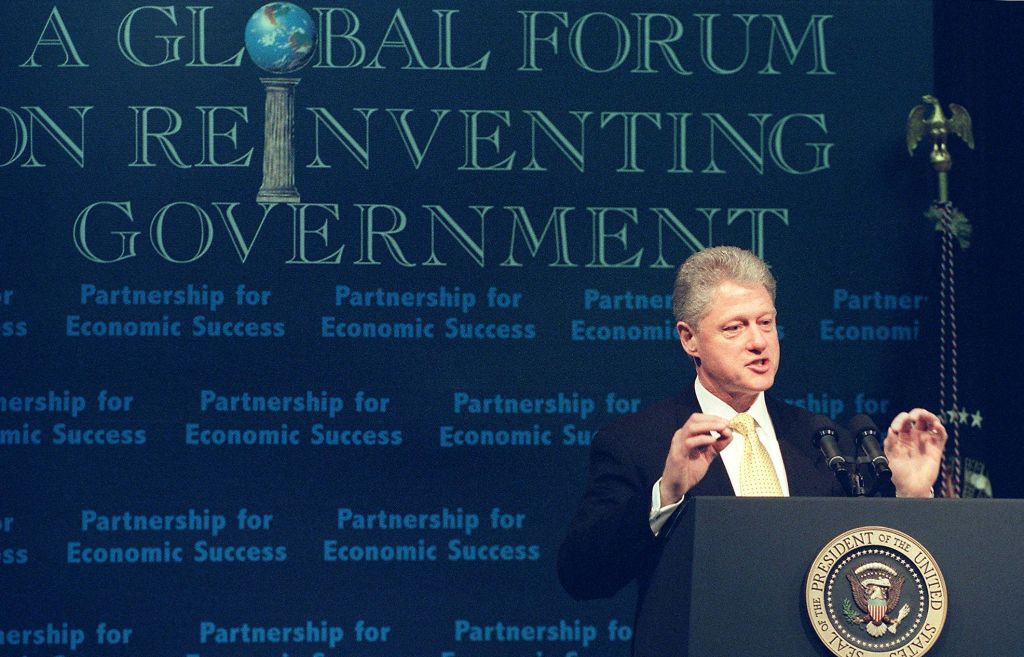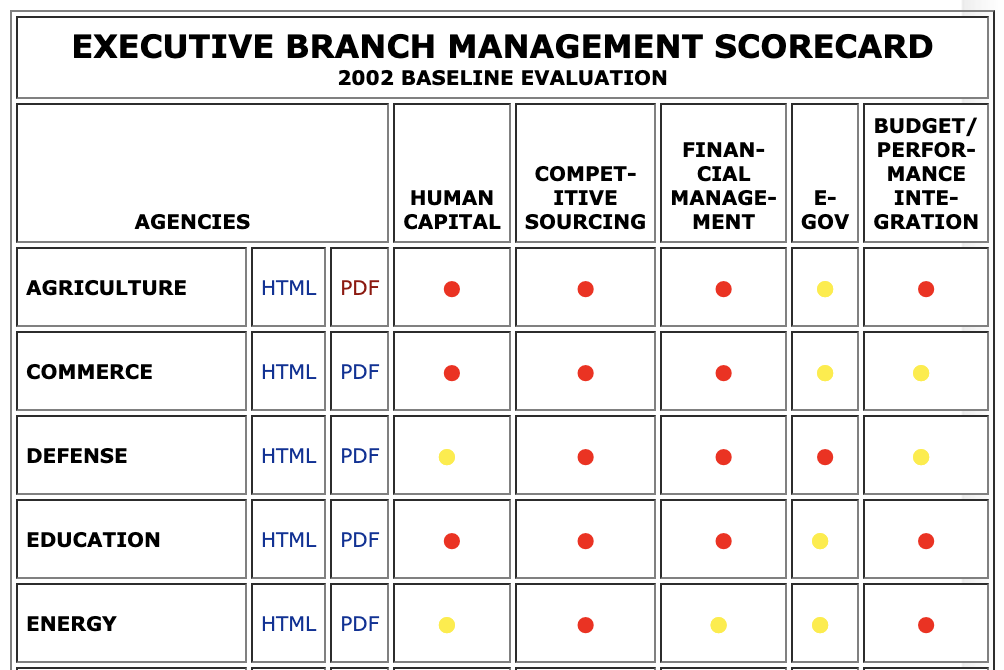'Long, long overdue': An oral history of the Government Performance and Results Act
Thirty years ago this month, a landmark piece of legislation aimed to change the very culture of the federal government.
In August 1993, President Bill Clinton signed the Government Performance and Results Act, a pioneering piece of legislation that required federal agencies to create strategic plans, set annual goals for programs, and measure actual performance against the targets. Clinton framed the law as a part of his effort to improve government performance:
It is important to restore the confidence of the American people in their government. It is important because, to the extent that our government works with greater efficiency and effectiveness and less unnecessary cost, it will strengthen the American economy as well as the bonds of our citizenship. … Everyone who has ever spent any time looking at how we do things, how decisions are made, how they tend to pile one on top of the other, year-in and year-out, without ever being examined in total or in terms of their effect, would say that this is an effort that is long, long overdue.
GPRA was a cornerstone of the Clinton administration’s Reinventing Government initiative, led by Vice President Al Gore. But over the years, it became part of not only the structure but also the culture of the federal government.
As GPRA reaches its 30th anniversary, it’s a great time to look back at how it evolved. Here, in the words of the people who were involved in the process, is the story of the birth and growth of results-oriented government.
Origin Story
The seeds of GPRA were initially bred and cultivated by a creative city manager in Sunnyvale, Calif. [John Mercer], and became the signature initiative of a fiscally conservative senator from Delaware, the late Bill Roth (he of Roth IRA fame). Until 1993, congressional Democrats consistently opposed Roth’s bill, largely driven by organized labor’s and consumer groups’ concerns that data would be used to justify de-funding worker and consumer protections. An axiom of management reform legislation is that it rarely succeeds without bipartisan support. Support by a new Democratic administration flipped the script. As I recall, the dress code for the victory celebrations was a t-shirt festooned with a cartoon image captioned “Ich bin ein Sunnyvale-er.”—Franklin Reeder, senior advisor for performance management, Office of Management and Budget
GPRA began with pilot projects in key agencies.
My recollection was that the concept for pilots was borrowed from the [Chief Financial Officers] Act, which antedated GPRA. [The CFO Act passed in 1990.]—Walter Groszyk, senior advisor for performance management, OMB
Choosing a name for the bill required some diplomacy.
John Mercer proposed “The More Bang for the Buck Act,” and I proposed “The Managing for Results Act.” I was inspired by the successful Managing for Results initiative I observed when visiting Australia to understand its performance system, as part of the background research on performance improvement initiatives that I was leading at [the General Accounting Office, later the Government Accountability Office]. The final result was “The Government Performance and Results Act”—a great compromise!—John Kamensky, deputy director of the National Partnership for Reinventing Government

Five-Year Timeline
Shortly after Morley Winograd arrived to replace Elaine Kamarck as Vice President Gore’s lead advisor on reinventing government in late 1997, I had the opportunity to brief him on GPRA and the timeline for its implementation. When the law was passed, it included a five-year time frame for full implementation. This meant that the first set of agency annual performance reports would be released publicly and to the Congress in the spring of 2000. Morley, looking ahead to Vice President Gore’s future presidential primary campaign, roared “who was the #!@*&% idiot who came up with that timing!” I meekly noted that I did help draft the bill. And survived his angry glare. He then buckled down to ensure the reports were well-crafted and meaningful.—John Kamensky
A number of people have asked how GPRA's five-year implementation timeline came to be. There are at least three reasons. The first was a "good government" attempt to learn to crawl before you walked. A number of other countries like Australia, New Zealand, Great Britain and others each began with some sort of experiment. It was hoped that by allowing agencies some time to experiment with performance measurement and strategic planning they could learn to understand how it could be applied to their programs.
A second reason was that then-OMB Director Dick Darman had instructed me, in no uncertain terms, that I should make sure that Bill Roth, who was Chairman of the Senate Governmental Affairs Committee, was "happy," but that I should "do nothing." I threaded that needle with the pilots, which meant that GPRA was optional for the first five years. This way we were able to keep Roth "happy" and yet ensure that the law would have no practical effect during Darman's tenure in the [George H.W.] Bush administration.
A third reason was that, at that time, all legislation needed to be "scored" for its cost. The GPRA bill was able to be scored a negligible amount because the pilots were voluntary. The first requirement for strategic plans and the use of performance measurement was pushed back five years.—Jonathan Breul, senior advisor to the deputy director for Management, OMB
Stoplight Scorecard
GPRA cleared a critical hurdle with the 2000 election. The newly elected president, George W. Bush, could have killed a program so closely associated with Gore, who he had defeated. Presidential transitions are often where a previous administration’s initiatives go to die. Instead, Bush transformed GPRA, with an emphasis on red-yellow-green color-coded scorecards grading each agency’s performance.
In the late 1990s, the National Partnership for Reinventing Government created an initiative to work closely with about 30 bureau-level agencies to improve their performance, like the Veterans Benefits Administration and the Patent and Trademark Office. We helped them develop rudimentary balanced scorecards using customer and employee survey data, and the performance data from their GPRA reporting systems. We crafted red-yellow-green stoplight scorecards for each agency based on these data and wanted to make them public, but a career OMB executive nixed the idea. Winograd said, “The president doesn’t want to be seen as choosing among his children.”

Then a few years later, OMB under newly-elected President George W. Bush began publicly publishing red-yellow-green scorecards showing the progress of major agencies towards meeting the performance criteria set out in the newly created President’s Management Agenda. I was out of government by then, but in a call with a career executive in OMB, I asked about the new scorecards, and he said, “Well, this is a different president.”—John Kamensky
As the political [appointees] stuck with implementing GPRA, we faced agency attitudes that ranged from strong reluctance to put plans and objectives together publicly to passionate lip service from some who complied but were very careful about exposing themselves. I remember the first strategic plans, which were less than strategic and barely plans. The famous stoplight in George W. Bush's administration and the continuing push [for implementation] have brought us to this much better place.—G. Edward DeSeve, deputy director for management and controller, OMB
Reforming the Reforms
GPRA continued to evolve and, in 2010, Congress passed the GPRA Modernization Act, or GPRA-MA. The new legislation, as the Government Accountability Office explained it, called for:
- A more coordinated and crosscutting approach to achieving meaningful results
- Efforts to address weaknesses in major management functions
- Ensuring performance information is both useful and used in decision-making
- Sustained leadership commitment and accountability for achieving results
- Engaging Congress in identifying management and performance issues to address
The act wove performance measurement far more deeply into agency operations.
OMB gets a call from Congressman Henry Cuellar’s staff. Cuellar wrote his doctoral dissertation on "A Comparative Analysis of Legislative Budget Oversight: Performance-Based Budgeting in the American States.” [Nancy] Pelosi had given Cuellar a green light to move a bill through the House. He decided to move a bill on performance management and successfully did. Amy Edwards Holmes was staffing Sen. Mark Warner, who launched Virginia Performs as governor. Amy and other key Warner staff work with the OMB team to amend GPRA 1993 and the Cuellar bill in what I continue to think are very sensible ways, informed by lessons learned on GPRA 1993 implementation along the way. Welcome, GPRA Modernization Act!—Shelley Metzenbaum, associate director for performance and personnel management, OMB

My involvement with GPRA and later GPRA-MA during a 25-year career at the Department of Transportation began in 1995 when I was hired as a program analyst to coordinate the development of a strategic implementation plan for the National Highway Traffic Safety Administration. It continued until 2020, when I retired as the senior advisor for strategic management at the Federal Highway Administration.
During my time at DOT, I was involved in the development of every department strategic plan, annual performance plan and report, modal administration multi-year strategic plans, annual budget integration and implementation plans, and unit-level operating plans and reports. These efforts were met with differing levels of interest and acceptance among executives, managers and staff. The biggest challenge was overcoming the compliance mentality and ensuring that the plans were useful and relevant to issues confronting the agency on a daily basis. Our success hinged largely on the managerial style and personal preferences of senior leadership. However, I can say that GPRA and GPRA-MA were the backstops that sustained these efforts.—J. Woody Stanley, senior advisor, strategic management, Federal Highway Administration
My favorite memory of all this is meeting with leaders at the Labor Department to discuss GPRA and performance measures. The attorneys present said that there was no way to measure what they did. I said that, in that case, we could just do without them and see how it went. At which point they began to list the things they did and began to talk about how to measure the impact.—John Koskinen, deputy director for management, OMB
I remind myself of the survey of over 100 federal components that John Kamensky did while at GAO before GPRA. He asked a series of questions about the existence of plans, goals, performance measures, etc. He got back generally positive results but when he went to verify the responses, he found many were overblown. The internal GAO reaction was that the agencies lied on the survey. John said actually it is much worse—they do not know the difference between a strategic plan and an annual work plan, or the difference between an output and an outcome. This finding contributed to the decision to include pilots in GPRA and to have a long lead time for government-wide implementation—to give agencies time and experience to build the capacity to manage for results.—J. Christopher Mihm, managing director, strategic issues, GAO
The Long View
Kudos to all who were there at the origins, and those who have worked since then to make this a durable, workable framework. The ability to build from and modify that framework was a testimony to the efforts of a group of bipartisan actors in and out of government who genuinely cared about evidence and performance, could find common ground on those topics, and talk to each other over the course of many years. I worry if these sorts of networks still exist, but hope springs eternal.—Donald Moynihan, McCourt Chair, McCourt School of Public Policy, Georgetown University
Continued investment in the Performance.gov website has enabled the public to explore strategic goals and objectives not just by agency but by crosscutting themes. It also makes more data available on the Biden administration and agency priorities such as customer experience, permitting, and personnel vetting reforms.
In sum, GPRA laid the groundwork for GPRA modernization, which incorporated lessons learned from other governments’ efforts to implement performance management systems. It shifted focus from a supply-side approach of producing information towards a demand-driven model that centered on supporting leadership in identifying and accomplishing their top organizational priorities, including by aligning the strategic planning process with Presidential transitions. Furthermore, GPRA and OMB’s Circular A-11 guidance have clarified the roles and responsibilities of key actors, including agency chief operating officers, performance improvement officers and goal leaders. It has institutionalized agency routines that engage these and other officials in the use of performance and evidence to inform key program decisions.
Donald F. Kettl compiled and edited this oral history based on an email conversation among the key players in GPRA’s creation and implementation. He is the the co-author, with William D. Eggers, of Bridgebuilders: How Government Can Transcend Boundaries to Solve Big Problems.




